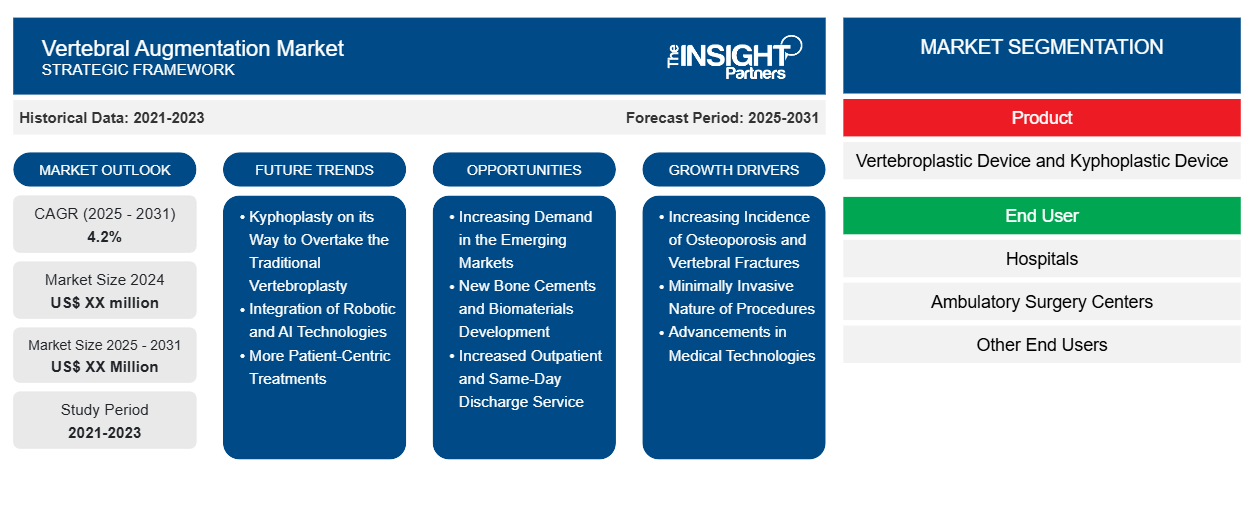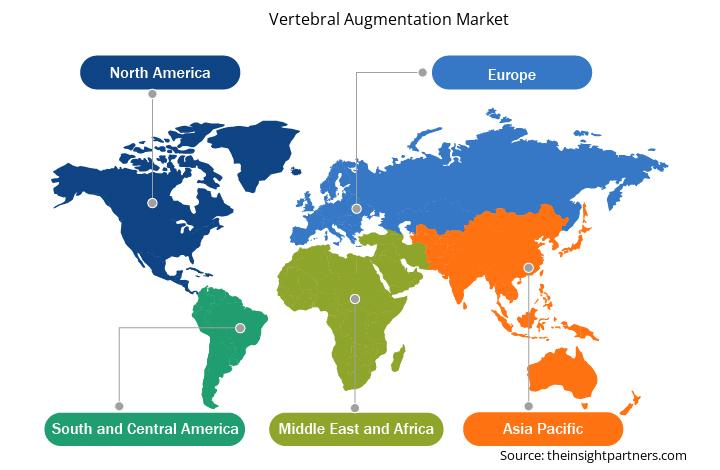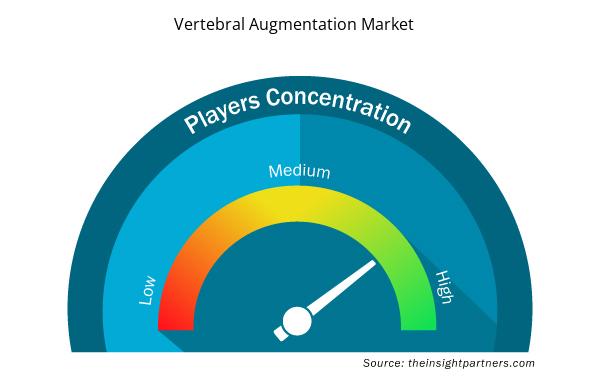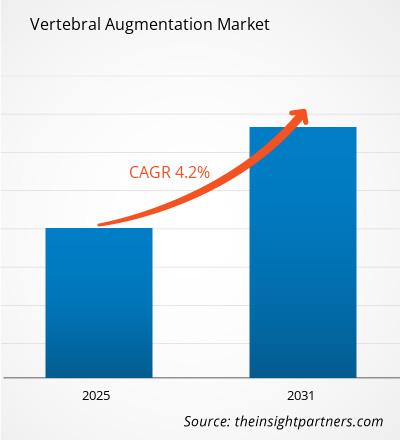The Vertebral Augmentation Market is expected to register a CAGR of 4.2% from 2025 to 2031, with a market size expanding from US$ XX million in 2024 to US$ XX Million by 2031.
The report is segmented by Product (Vertebroplastic Device and Kyphoplastic Device).The report further presents analysis based on the End User (Hospitals, Ambulatory Surgery Centers, and Other End Users). The global analysis is further broken-down at regional level and major countries. The Report Offers the Value in USD for the above analysis and segments.
Purpose of the Report
The report Vertebral Augmentation Market by The Insight Partners aims to describe the present landscape and future growth, top driving factors, challenges, and opportunities. This will provide insights to various business stakeholders, such as:
- Technology Providers/Manufacturers: To understand the evolving market dynamics and know the potential growth opportunities, enabling them to make informed strategic decisions.
- Investors: To conduct a comprehensive trend analysis regarding the market growth rate, market financial projections, and opportunities that exist across the value chain.
- Regulatory bodies: To regulate policies and police activities in the market with the aim of minimizing abuse, preserving investor trust and confidence, and upholding the integrity and stability of the market.
Vertebral Augmentation Market Segmentation
Product
- Vertebroplastic Device and Kyphoplastic Device
End User
- Hospitals
- Ambulatory Surgery Centers
- Other End Users
Customize This Report To Suit Your Requirement
You will get customization on any report - free of charge - including parts of this report, or country-level analysis, Excel Data pack, as well as avail great offers and discounts for start-ups & universities
Vertebral Augmentation Market: Strategic Insights

- Get Top Key Market Trends of this report.This FREE sample will include data analysis, ranging from market trends to estimates and forecasts.
Vertebral Augmentation Market Growth Drivers
- Increasing Incidence of Osteoporosis and Vertebral Fractures: The increasing prevalence of osteoporosis, especially among the aged, is driving the vertebral augmentation market. Osteoporotic fractures are one of the major causes of vertebral compression fractures or VCFs, thus increasing the number of vertebroplasty and kyphoplasty procedures, respectively. As more cases of osteoporosis are diagnosed, there is an increased need for effective treatments to address these fractures.
- Minimally Invasive Nature of Procedures: The main benefits of minimally invasive vertebral augmentation procedures, such as vertebroplasty and kyphoplasty, over traditional surgery include a shorter recovery period, reduced pain, and fewer days in the hospital. Such benefits are increasingly making patients opt for these treatments, thus propelling the growth of the vertebral augmentation market. The key driver for this market is increased demand for minimally invasive therapies.
- Advancements in Medical Technologies: Some important technical advancement on vertebral augmentation procedures and development of better surgical instruments and imaging systems along with advances in cement formulations enhance treatments at accuracy and effectiveness. Vertebroplasty and Kyphoplasty, together, are now made much safer and more effective in application, which in turn escalates their use for fracture treatment. Further advancements can be expected from the developing technology, leading to high increase in procedural volume as well as in the effectiveness of treatments.
Vertebral Augmentation Market Future Trends
- Kyphoplasty on its Way to Overtake the Traditional Vertebroplasty: Kyphoplasty or the procedure in which an inflatable balloon is inserted and inflated inside the vertebra before injecting bone cement was gaining popularity over traditional vertebroplasty since it not only relieved pain, but also restored vertebral height and corrected spinal deformities. As more studies showed its efficacy, kyphoplasty became the most preferred choice for the treatment of fractured vertebrae.
- Integration of Robotic and AI Technologies: Vertebral augmentation procedures are increasingly being integrated with robotic systems and AI technologies. This will likely improve the accuracy of needle placement, imaging sharpness, and allow for real-time decision making. As these systems become more advanced, they can only improve procedural outcomes, reduce complications, and augment rates of adoption.
- More Patient-Centric Treatments: This can be seen in a more personalized approach to vertebral augmentation, where the need to care for patients is at a higher level. It provides personalized medical treatments based on individual fractures, bone quality, or health conditions. All of these ensure better results with faster recovery and better satisfaction for the patient. Rising demand for vertebral augmentation drives the market.
Vertebral Augmentation Market Opportunities
- Increasing Demand in the Emerging Markets: The growing aging population in emerging markets, coupled with a rising incidence of osteoporosis, has created enormous growth opportunities for the vertebral augmentation market. Demand for advanced medical treatments, such as vertebroplasty and kyphoplasty, is on the rise with better health care infrastructure. Companies can exploit this trend by establishing themselves in these regions with affordable and accessible treatment options.
- New Bone Cements and Biomaterials Development: New bone cements and biomaterials for use in vertebral augmentation present the opportunity to improve further both the safety and effectiveness of those procedures. New formulations for such cements could both help the flow of cements and reduce complications, mimic closer natural bone properties; new biomaterials of the advanced type could well offer improved outcomes for more patients and drive market expansion long-term.
- Increased Outpatient and Same-Day Discharge Service: Increasing the number of outpatient vertebral augmentation procedures opens new market opportunities. Most procedures, which could not be performed as an outpatient previously, can now be completed on an outpatient basis due to advancements in minimally invasive techniques and anesthesia. The cost savings to healthcare providers and greater convenience for patients make vertebral augmentation procedures more attractive to use.
Vertebral Augmentation Market Regional Insights
The regional trends and factors influencing the Vertebral Augmentation Market throughout the forecast period have been thoroughly explained by the analysts at Insight Partners. This section also discusses Vertebral Augmentation Market segments and geography across North America, Europe, Asia Pacific, Middle East and Africa, and South and Central America.

- Get the Regional Specific Data for Vertebral Augmentation Market
Vertebral Augmentation Market Report Scope
| Report Attribute | Details |
|---|---|
| Market size in 2024 | US$ XX million |
| Market Size by 2031 | US$ XX Million |
| Global CAGR (2025 - 2031) | 4.2% |
| Historical Data | 2021-2023 |
| Forecast period | 2025-2031 |
| Segments Covered |
By Product
|
| Regions and Countries Covered | North America
|
| Market leaders and key company profiles |
Vertebral Augmentation Market Players Density: Understanding Its Impact on Business Dynamics
The Vertebral Augmentation Market market is growing rapidly, driven by increasing end-user demand due to factors such as evolving consumer preferences, technological advancements, and greater awareness of the product's benefits. As demand rises, businesses are expanding their offerings, innovating to meet consumer needs, and capitalizing on emerging trends, which further fuels market growth.
Market players density refers to the distribution of firms or companies operating within a particular market or industry. It indicates how many competitors (market players) are present in a given market space relative to its size or total market value.
Major Companies operating in the Vertebral Augmentation Market are:
- Medtronic
- Stryker Corporation
- DePuy Synthes (Johnson & Johnson)
- Zimmer Biomet
- Cook Medical
- Boston Scientific Corporation
Disclaimer: The companies listed above are not ranked in any particular order.

- Get the Vertebral Augmentation Market top key players overview
Key Selling Points
- Comprehensive Coverage: The report comprehensively covers the analysis of products, services, types, and end users of the Vertebral Augmentation Market, providing a holistic landscape.
- Expert Analysis: The report is compiled based on the in-depth understanding of industry experts and analysts.
- Up-to-date Information: The report assures business relevance due to its coverage of recent information and data trends.
- Customization Options: This report can be customized to cater to specific client requirements and suit the business strategies aptly.
The research report on the Vertebral Augmentation Market can, therefore, help spearhead the trail of decoding and understanding the industry scenario and growth prospects. Although there can be a few valid concerns, the overall benefits of this report tend to outweigh the disadvantages.
- Historical Analysis (2 Years), Base Year, Forecast (7 Years) with CAGR
- PEST and SWOT Analysis
- Market Size Value / Volume - Global, Regional, Country
- Industry and Competitive Landscape
- Excel Dataset


- Portable Power Station Market
- Nitrogenous Fertilizer Market
- Visualization and 3D Rendering Software Market
- Medical Devices Market
- Adaptive Traffic Control System Market
- Human Microbiome Market
- Gas Engine Market
- Aircraft Wire and Cable Market
- Cell Line Development Market
- Nuclear Decommissioning Services Market

Report Coverage
Revenue forecast, Company Analysis, Industry landscape, Growth factors, and Trends

Segment Covered
This text is related
to segments covered.

Regional Scope
North America, Europe, Asia Pacific, Middle East & Africa, South & Central America

Country Scope
This text is related
to country scope.
Frequently Asked Questions
The increasing prevalence of osteoporosis and vertebral fractures, the growing demand for minimally invasive treatments, and advancements in medical technologies are likely to drive market growth.
The two key techniques in vertebral augmentation includes vertebroplasty and kyphoplasty. These techniques are used to stabilize fractures in the spine and to reduce pain.
The advantages of these minimally invasive procedures, such as vertebroplasty and kyphoplasty, include reduced recovery time, fewer complications, less pain, and shorter hospital stays. These factors have increased their popularity over traditional surgical options.
Technological advancements such as AI-powered imaging have improved the accuracy and precision of vertebral augmentation procedures.
Kyphoplasty is becoming more popular than vertebroplasty because it restores the vertebral height and corrects the deformity of the spine besides alleviating pain. As clinical studies continue to support its efficacy, it has become the preferred treatment for vertebral compression fractures.
Emerging markets present opportunities due to the increasing aging population and rising awareness of osteoporosis and spinal conditions.
Trends and growth analysis reports related to Life Sciences : READ MORE..
- Medtronic
- Stryker Corporation
- DePuy Synthes (Johnson & Johnson)
- Zimmer Biomet
- Cook Medical
- Boston Scientific Corporation
- NuVasive, Inc.
- Globus Medical
- Mazor Robotics
- AlloSource

 Get Free Sample For
Get Free Sample For